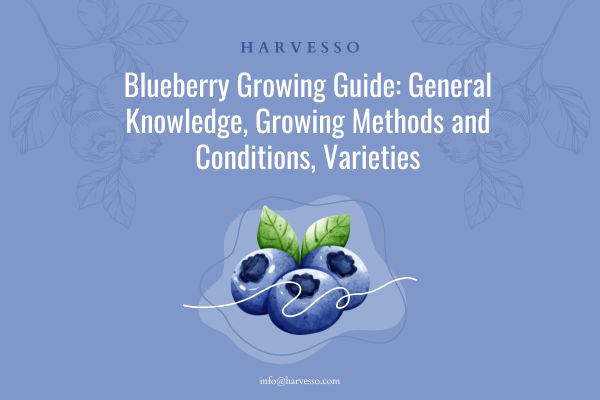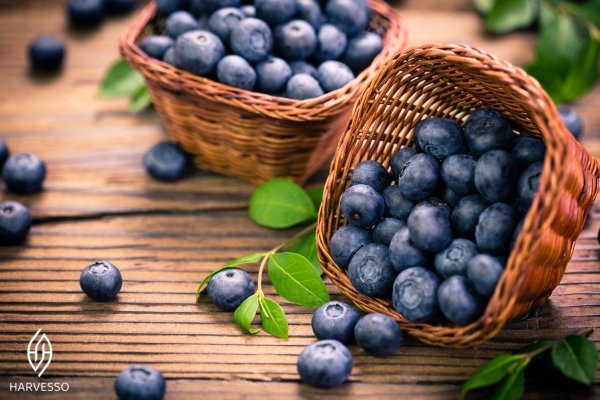
History
Since the first crop of blueberries traveled from the farm to the table, these little blueberries help people live healthier and fuller lives. In the early 20th century, people did not think about growing wild blueberries, but Elizabeth White, a farmer's daughter in New Jersey, decided to grow blueberries. In 1911, he teamed up with botanist Frederick Coville to identify wild plants with the most desirable characteristics and to create new species of blueberries by cultivating bushes. In 1916, they harvested and sold the first harvest of blueberries.
Blueberries belong to the genus Vaccinium, which is native to North America. Blueberry bushes have oblong and pointed leaves that turn the reddish color in autumn. The flowers open in late spring in the form of small, white, and bell-shaped. Flowers become delicious and edible berries that change from green to purple-blue. These berries are rich in vitamins C, A, and K1 and are used in the treatment of many diseases.
Most blueberries are grown commercially in 27 countries in mild climates. During 2002 and 2011, world blueberry production increased from 230,769 tons to 356,533 tons, an annual increase of 5.45%. Blueberry production in 2011 was 13.66% higher than the previous year and 54.50% higher than in the 2002 calendar year. According to the results of 2019 (FAOSTAT 2019), the top five countries producing blueberries include the United States, Canada, Peru, Spain, and Mexico. The United States is the largest producer of blueberries with a share of 39% between 2017 and 2019, followed by Canada (25%), Peru (14%), Spain (6%), and Mexico (6%). Known as a superfood, blueberries have become a favorite choice of consumers in the developed world. By 2024, the global blueberry market is projected to reach $ 4.5 billion, with an annual growth rate of 6.7% starting in 2019.
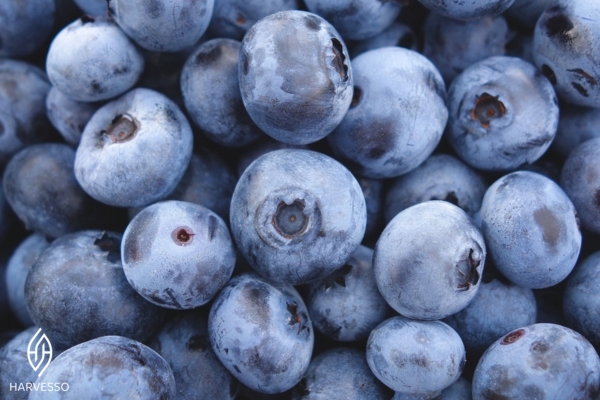
Growing Method
Over the past 20 years, the growing area and production of blueberries in the world have increased dramatically. Having increased demand for blueberry, producers attempt to get better varieties in terms of appearance, color, size, and taste. Growing methods, irrigation, pruning, spraying, etc. considerably affect the quality and size of berries as well.
Despite the growing global demand for blueberries, the supply of blueberries is still limited, which in turn affects the growth of the market. Growers are looking for several ways to meet the growing demand and use the economic potential of the blueberry market. Soilless cultivation can address the shortcomings of traditional land cultivation, and therefore, there has been a strong trend among farmers in recent years to grow blueberries in the substrate. Although it is widely known to grow plants in pot/container, it is still not usual for perennial plants such as blueberries to grow in a soilless environment.
The growth rate in the substrate is higher than the one in the soil. With proper management, the productivity of the first year in the substrate is known to be higher than that of the soil. Thus, the product grown on the substrate allows to get up to 50 percent more crop yield per hectare during the first year of production than the same type of product grown in the soil. Research shows that if the yield per hectare of land for blueberries during the first year of production is up to 10 tons, this figure can be up to 15 tons in the substrate. Also, a soilless environment enables plants to produce earlier, which allows the market entry date to move forward. These figures have been confirmed after more than eight years of experience and research on this type of product in the world's leading producers.
Today, land-based agriculture faces challenges such as land and water shortages, climate change, rising agribusiness costs (e.g., fertilizers, fuels, pesticides), land depletion, and degradation because of over-cultivation. Such problems have resulted in the widespread use of landless farming or hydroponics, a method of growing crops without the use of land. Growing plants in a soilless environment can bring many benefits:
• Potentially higher productivity
• Possibility of growing plants in unsuitable soil conditions or highly contaminated soil
• Optimizing labor in cultivation, planting, spraying, irrigation, and other traditional practices
• More efficient use of water and nutrients, which in turn significantly reduces costs and at the same time reduces pollution in land and water flows.
Farmers who want to maximize the benefits of growing in a soilless environment should have a high level of knowledge and experience about this system and be equipped with irrigation and spraying equipment as well.
How to grow blueberries on the substrate, and what to look for in this process?
What makes landless farming successful is the management of irrigation and its frequency depending on the irrigation system, climate, water type, and environment. Besides, pH, fertilization planning, and the use of discs placed in plant beds against weeds play a key role. Substrates have a high aeration capacity, which favors the development of plant roots. Special pots for blueberries support the proper growth of the plant's roots. Since they are sensitive to moisture, soilless planting creates perfect drainage. The root system of the plant grows faster than the soil in the pot and the meantime allows to get more crops by distributing water and fertilizer evenly.
Unlike many plants, blueberries love soils with high acidity, so it is difficult for many farmers to grow this berry traditionally. However, soilless planting allows to grow the plant at the right level of pH, and this is one of the main factors for the productivity of blueberries. The necessary elements for plant nutrition are determined according to the pH level. Iron and calcium deficiency can occur at high levels and may trigger the yellowing of the leaves and burning of the tips. The most suitable pH for blueberries varies between 4.5-5.2 and should be monitored regularly. To grow blueberries in soil with the normal level of pH (7.0), at least six months before the planting, it is necessary to make the soil nutritious by adding various sulfur and water-mixed acids.
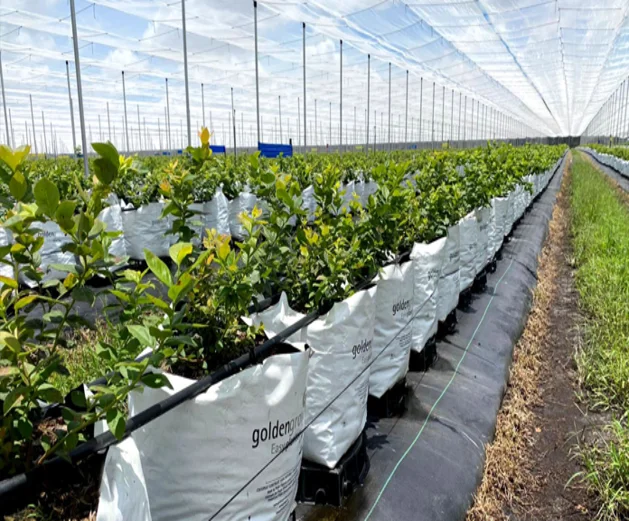
Irrigation of blueberry bushes can be considered hard, as this plant is sensitive to under-irrigation and over-irrigation. In the growing process, nourishing applications should be continuous and irrigation should always be done with acidified water. It needs to be watered and fed as much as necessary to get a healthy crop and keep even moisture in the pot. Thus, water and nutrients must always be available at every hour of the day to meet the needs of the plant. The irrigation system depends on the environmental conditions and the stage of plant growth and is determined accordingly. In hot conditions, it may require watering several times a day. When added water is used to bring the substrate to full-field capacity the plant may face a fading point. In cool winter conditions, the plant can last for several days without requiring watering. The duration and frequency of irrigation can change constantly.
The target EC level also varies at different times of the year and various stages of growth. EC is higher with less irrigation in winter and decreases in summer as irrigation increases. Excessive irrigation can saturate the substrate and reduce oxygen levels. All this adversely affects the growth of the plant. Thus, the plant develops root disease and increases the death risk.
After long-term irrigation or a few short daily irrigations, water must flow from the bottom of the pots where the substrate is located. After irrigation, 15-25% of the total water should flow. If 1000 ml of liquid is poured on the plant and 300 ml of it flows from the bottom of the pot or container, then the flow rate is 30%. The absence of water or the observation of low flow indicates that there is no sufficient irrigation. In this case, the salts can cause root damage and problems in plant growth.
Pine bark, wood bran, forest waste, peat, and other organic substrates are suitable for growing blueberries. These substrates are considered suitable for enrichment with acidity and nutrients, along with increasing soil moisture. Cocopeat is almost the basis of the substrate used for blueberries in the world. Coconut substrate is considered to be a sustainable and favorable environment for the natural growth of plants due to its ability to retain water and transfer nutrients efficiently. However, the coconut substrate is best flushed and buffered before planting. Plants such as tomatoes, strawberries, and peppers grow on 100% coconut substrate and do not need to be pre-flushed. According to research (Scientia Hosticulturae, 2019), it is not suitable to grow blueberries in coconut shells. However, coconut peat or wood bran is one of the most fertile substrates for blueberries due to its chemical reactions and ability to maintain the desired pH level. The coconut substrate used in the berry mixture must be flushed and prepared for the plant.
The best way to flush the substrate is to fill the containers and place them inside the tunnel where plants will be planted. Then, every two hours for 15 minutes during the day, fertilized water should be added at EC 1.5 level and it should flow down from the bottom.
It is a good idea to use ammonium sulfate to prevent potential nitrogen leaching in this process. During fertilization, calcium and magnesium will replace excess potassium, sodium, or chloride in the substrate. This operation should be continued for 3 or 4 days until the EC is 3.0 in the drainage water. Keep 24-48 hours without water before planting. In the absence of fertilizer, the usage of water will help to flush away the excess elements in the substrate.
Nitrogen (N): Nitrogen (N) is essential for plant health, growth, fruiting, and the formation and development of buds for next year's harvest. Symptoms of nitrogen deficiency include yellowing of the blueberry leaves (chlorosis) and a light red color. This is typically observed in older leaves that are initially below the cover, which can lead to crustacean-like discoloration, defoliation, and, in some cases, crop failure. Deficiencies can also limit the growth of new plant clusters. Excessive amounts of nitrogen can cause excessive vegetative growth with larger and darker green leaves. Excess nitrogen can lead berries to be small and ripe later. Common sources of nitrogen in blueberry fertilizers include ammonium sulfate, urea, mono, and diammonium phosphate, and various forms of organic nitrogen. Blueberries prefer the ammonium form of nitrogen to the nitrate form. If the pH is not higher than 5.5, nitrogen can be used with ammonium as part of a small amount of fertilizer mixture. Only N nitrate fertilizers should not be used in the production of blueberries. Ammonium sulfate is often used because ammonium helps maintain the pH at the required level, but should be used with caution when the pH approaches the lower range of the recommended level.
Phosphorus (P): Phosphorus is involved in root growth and is vital for energy transfer processes. PH tests should be performed before planting to determine if P application is necessary. Phosphorus deficiency includes the formation of small leaves and a dark green or purple discoloration at the edge of the leaf. In the case of phosphorus deficiency, it is usually sufficient to apply superphosphate, mono ammonium phosphate, or diammonium phosphate.
Potassium (K): Potassium is involved in the photosynthesis and regulation of water in plants. Although some growers use potassium chloride, blueberry plants are fed with potassium sulfate. Although potassium chloride is a cheap source of potassium, the blueberry plant is sensitive to chloride and soil or substrate with high chloride content can cause serious damage to the roots. The symptoms of potassium deficiency are similar to the damage caused by drought, and the ends are burnt with various holes in the leaves.
Magnesium (Mg): Magnesium plays an important role in the development of the plant. Magnesium deficiency may be quite common in blueberry production due to the high calcium in irrigation water. Symptoms of deficiency are characterized by yellowing or reddening of the edges in the leaves, while the middle of the leaf remains green. Symptoms usually appear on older leaves. Magnesium deficiency can be treated with the application of magnesium sulfate or hydrated dolomitic lime.
Calcium (Ca): Blueberries do not require significant amounts of calcium, and calcium deficiency is rare. When the pH is below the recommended level, calcium deficiency can occur and affect the quality of the fruit.
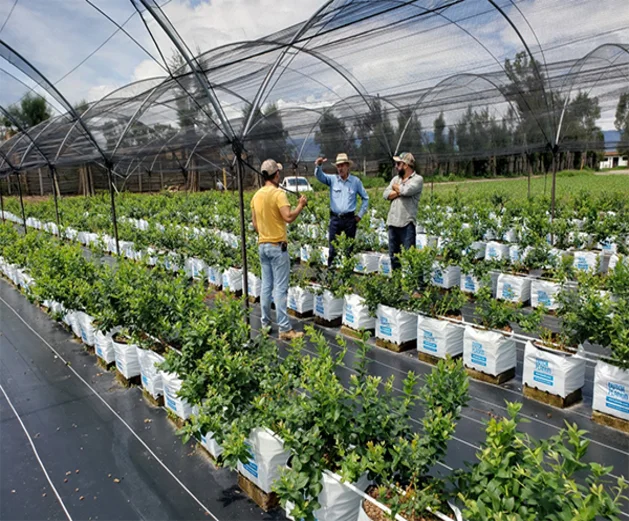
Advantages and disadvantages of growing blueberries in the substrate
Advantages:
• Growers gain more control over fertilizer balance and moisture content
• Have healthier plants
• More uniform growth
• Rapid growth and productivity
• Ability to change and manage the root zone environment
• Transfer pots or plant containers to appropriate conditions
• Ability to measure and recycle water and nutrients discharged from trays
Difficulties:
• Requires higher technical experience than growing the plant in the soil
• High responsibility for intensive irrigation system management
• Measurement of daily water volume, nutrition level, and attention to fluctuations in pH / EC values
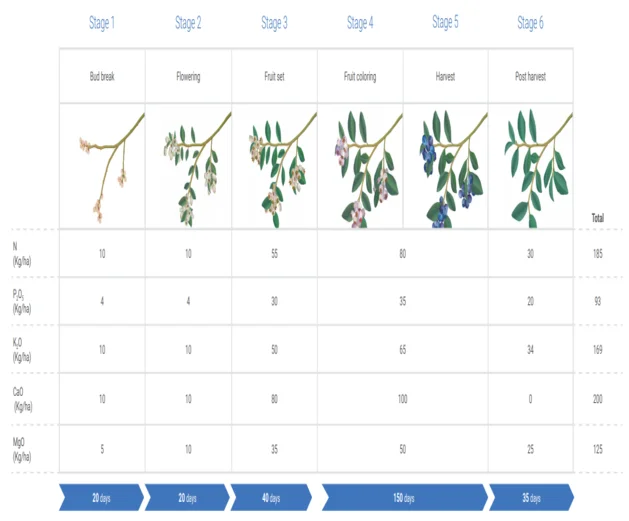
Blueberry varieties
There are several varieties of blueberries, and these varieties differ in several characteristics, including the harvest season, fruit quality, tolerance, growth habits, strength, and disease resistance. There are 5 main types of blueberries: low-bush, northern bush, southern bush, half-bush, and rabbit eye. Of these, the northern high-bush blueberry variety is one of the most widely grown in the world.
As the name suggests, low blueberry varieties are generally up to 1.5 meters tall. This type of blueberry bushes needs less pruning. Top Hat is a dwarf, low-growing variety and is grown in private gardens as well as in decorative landscape design.
Northern high-bush blueberries are native to the eastern and northeastern United States. Height varies between 1.5-2.5 meters. These species require regular pruning. The following is a list of high cola varieties:
• Bluecrop - is the most widely planted mid-season cultivar in the world. It produces high yields of medium-sized, firm fruit with good flavor. It is hardy in all but the coldest sites and can be machine harvested. The canes tend to be weepy so care should be taken to maintain the shape. It has very good disease resistance. Winter hardy to -25°C.
• Bluegold - produces medium-sized berries with small, dry blossom scars. It has good flavor and firmness. It is a low-growing bush with many branches and very good hardiness. Winter hardy to - 25°C.
• Blueray - is also a widely planted mid-season cultivar. Fruit size is very good with good flavor and high yield potential. Extra pruning is needed with this spreading bush, as canes tend to weep due to heavy bearing. It has very good winter hardiness. Winter hardy to -25°C.
• Duke - is considered the best early-season cultivar available. It has a late bloom that avoids many frosts and still produces an early crop. The fruit size and quality are very good, but the flavor can be bland if picked late. It can be machine harvested. Frost tolerance and winter hardiness are good. Winter hardy to -25°C.
• Elliot - is a very late season berry with very good shelf life, 30-45 days in a modified atmosphere. The fruit is large and firm but can be tart because it turns blue before ripe. It is a good producer. The bush has an upright habit and forms a dense center that should be pruned to promote air movement. Winter hardy to -25°C
• Jersey - is an old (1928) cultivar that is adapted to a wide soil range. It has high yields of machine-harvested fruit, but the berries are small and soft. The bush has an upright habit and forms a dense center that should be pruned to promote air movement. Winter hardy to -35°C.
• Patriot - is winter hardy but frost sensitive due to early bloom. The fruit is large and firm with a small blossom scar. Full ripeness is needed for good flavor and sweetness. The bush is small to medium and grows slowly but is still productive. It must be pruned hard for large fruit and be fully ripe for the best flavor. Suspected susceptibility to tomato ringspot virus has limited its use in recent years, but it is more tolerant to heavier soils than most varieties. Winter hardy to -25°C.
• Rubel - is a wild selection that can be grown for the natural foods market. The fruit is small, firm and dark like low-bush varieties. The flavor is fair and yields are moderate. It has very good winter hardiness. Winter hardy to -35°C.
Southern high-bush blueberry species can reach a height of 1.8-2.5 meters. This type of blueberry allows berry production in temperate winter areas as they require less cold air to bring buds and flowers. Because it blooms in late winter, frost can damage the fruit. For this reason, southern high-bush varieties are grown in areas with very mild winters. Some southern high-bush blueberry varieties are:
• Golf Coast
• Misty
• Oneal
• Ozarkblue
• Sharpblue
• Sunshine Blue
The rabbiteye blueberry variety is found in the southeastern United States and ranges in height from 1.8 to 3 meters. These species were created to harvest in areas with long and hot summer. It is considered more sensitive to winter cold. Many of these older varieties have thicker skin and clearer seeds. Recommended varieties include:
• Brightwell
• Climax
• Powderblue
• Premier
• Tifblue
The half-bush variety is formed from the northern high and low berry varieties and is temperature tolerant between 1-7 ° C. Half-sized blueberry bushes grow up to 0.9-1.2 meters. Suitable for growing in a container. Among the varieties of half-bush can be found:
• Chippewa - a is a very winter hardy half-high variety that is productive with large firm fruit. Winter hardy to -35°C.
• Northland - is very winter hardy. It is an extremely productive half-high type with medium sized, dark, soft fruit. It can reach 1.25 m tall and produces many canes, which require heavy annual pruning. Winter hardy to -35°C.
• Northsky
• Friendship
• Northcountry

Post-harvest management
Alike other fruits, the next stage is post-harvest management which aims to reach the consumer with a quality product. The quality of the product is determined by several factors such as color, shape, non-rot, sweetness/acidity balance, and aroma.
Today, there are many varieties of blueberries grown for commercial purposes that can be distinguished in many ways, including growth habits, production history, taste, and other factors. It is also important to note that the post-harvest process may vary between varieties, as they may have different metabolism, putrefaction susceptibility, firmness, and sugar/acid ratio. But they all have one thing in common, they are characterized by very rapid deterioration after harvesting. For this reason, it is very difficult to market a product from a country like Chile, because the main consumer markets are far away (USA, Europe). Therefore, after harvesting, the fruit must maintain its integrity and quality for a long time or be processed at the place of production.
Because blueberries are smaller than other fruits, they can lose water more quickly, but the cooling process takes longer than others. It should be noted that the peel on the berries is thin, so they can be easily damaged during harvesting and transportation. Therefore, in addition to the production process, the post-harvesting period is also important to deliver a quality product to the end-user. The quality of the product can be grouped according to visual, organoleptic, and composition. Visual qualities include the appearance of blueberries: (i) a single blue fruit, (ii) the presence of wax on the surface of the fruit (known as bloom) indicating that the product is fresh, (iii) absence of defects such as mechanical damage and decay, (iv) shape and size of the fruit, and (v) adequate firmness. Organoleptic quality is determined by the number of sugars, acids, and volatile compounds that create the characteristic aroma of the fruit.
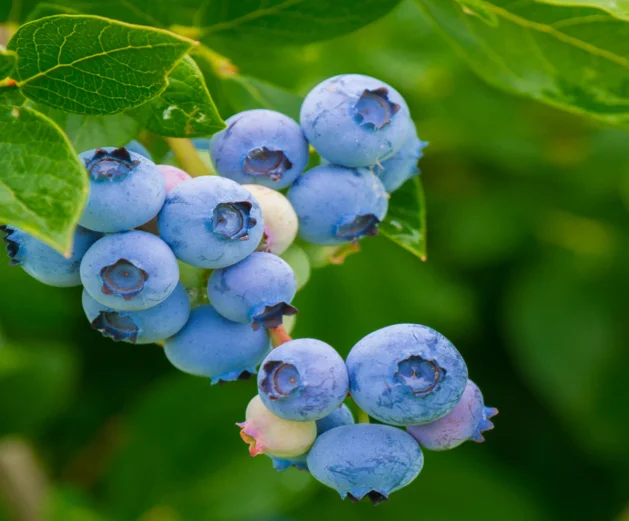
One of the most important factors in prolonging the post-harvest life of blueberries is the use of shading during harvesting and their transportation to temperature-controlled packaging warehouses as soon as possible. If it is not possible to transport the product quickly, it is recommended to cover the collected containers with materials that reflect sunlight.
After harvesting, it is recommended to bring the berries to a storage temperature of 0-1 ° C for 1 hour and keep the packaging in the same place, as it retains the ambient temperature. The berries should be stored in a moist place to prevent loss of water. In this case, the decay process is slower and it is possible to store the product for a long time.
